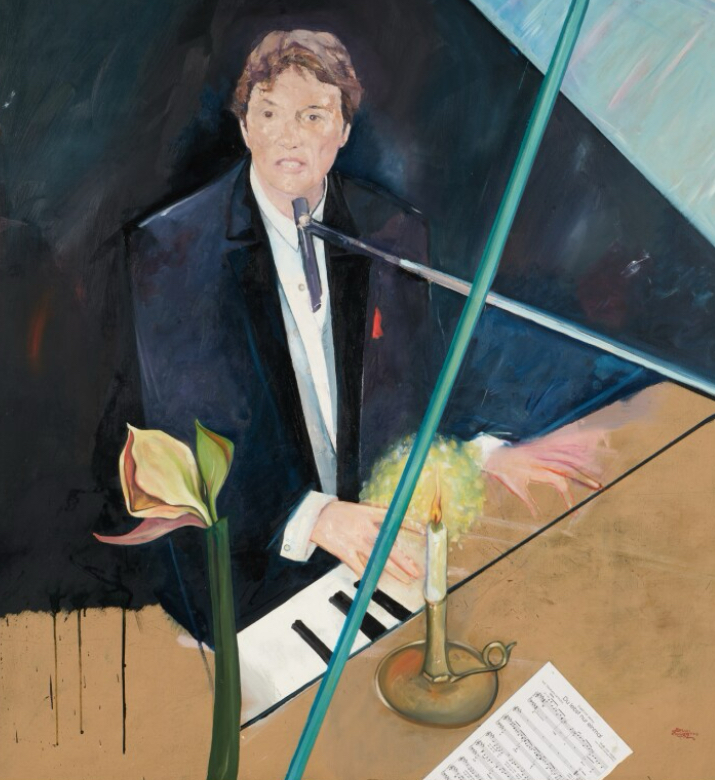In a dimly lit room filled with whispers of the past, Uni Jürgens sat at a grand piano. The light from the antique chandelier reflected off the glossy surface of the instrument, casting soft, fragmented glows on the walls. Her fingers hovered over the keys, a breath away from releasing melodies that seemed to hang in the air, waiting.
Uni, a prodigious pianist known for her evocative interpretations of classical and modern works, was not just a musician. She was an artist in every sense of the word, blending sound and soul. Tonight, she played for a private gathering honoring one of her inspirations: the works of the renowned artist Bruno Bruni.
The Intersection of Music and Visual Art
Bruno Bruni, a celebrated Italian-German artist, is known for his delicate yet bold depictions of the human form. His works often convey an intense emotional depth, with every line and curve evoking longing, passion, and vulnerability. Bruni’s art captures a stillness that feels alive, much like the pauses in music that speak louder than sound. It was this shared sensibility that had always drawn Uni Jürgens to his work.
Uni believed that music and visual art shared a language beyond words. Just as Bruni’s charcoal strokes captured the rawness of emotion, the movement of Uni’s fingers on the piano keys painted stories without the need for narration. The parallels between their art forms were undeniable. While Bruni’s canvases spoke to the eyes, Uni’s music resonated with the ears—and together, they reached the soul.
The Evening’s Theme: A Tribute to Bruni
The gathering was intimate, attended by art connoisseurs, musicians, and collectors who admired both Bruni’s visual artistry and Uni’s musical genius. The evening was a celebration of creative harmony, with Uni’s piano performance acting as a bridge between Bruni’s two-dimensional world and the immersive soundscape of music.
As the program began, a projection of Bruni’s works illuminated the room. His iconic drawings of the human figure, rendered with precision and tenderness, loomed large on the walls. Each piece seemed to breathe, as if waiting for Uni to awaken them with her music.
Uni began her set with Debussy’s “Clair de Lune,” a piece as fluid and evocative as the figures in Bruni’s paintings. The gentle ebb and flow of the notes mirrored the artist’s subtle gradients and lines. The audience closed their eyes, letting the music guide them through the contours of Bruni’s art.
A Personal Connection
Uni’s admiration for Bruno Bruni wasn’t purely academic or professional—it was deeply personal. As a child, she had stumbled upon a book of his sketches in her grandfather’s library. Though she didn’t fully understand the themes of his work at the time, she felt an immediate connection. His art seemed to hum with the same kind of energy she found in music.
Years later, when she became a performer, Uni often found herself returning to Bruni’s art for inspiration. Before composing or interpreting a piece, she would spend hours studying his drawings, tracing the lines with her eyes, and imagining the stories behind them. Bruni’s work became a muse, helping her channel her emotions into music.
The Power of Silence and Space
One of the defining features of Bruni’s work is his use of negative space. The absence of detail in certain areas draws attention to what is present, creating a balance that invites contemplation. Similarly, Uni’s piano playing was marked by her mastery of silence. Her pauses were deliberate, giving each note room to breathe.
During the performance, she played Arvo Pärt’s “Spiegel im Spiegel,” a minimalist composition that relies on repetition and space to create an ethereal atmosphere. As the notes resonated through the room, they seemed to echo Bruni’s philosophy: that simplicity can be as profound as complexity.
Connects Across Mediums
The highlight of the evening came when Uni performed an improvisational piece inspired by one of Bruni’s lesser-known works, a charcoal sketch titled “L’attesa” (The Waiting). The sketch depicted a woman seated on the edge of a chair, her gaze distant and contemplative. Uni had spent weeks studying the piece, trying to translate its essence into music.
Her performance was hauntingly beautiful, capturing the tension and vulnerability of the figure in Bruni’s sketch. The music ebbed and flowed, with moments of quiet introspection followed by surges of intensity. It was as if the piano itself had become a canvas, and Uni’s fingers were painting Bruni’s vision with sound.
Audience Reflections
After the performance, the audience was invited to share their thoughts. One art historian remarked on the seamless interplay between Bruni’s visual language and Uni’s musical interpretation. “It’s as if the two art forms were speaking to each other,” she said.
A musician in the audience added, “What struck me most was how Uni brought out the emotional core of Bruni’s work. It wasn’t just a performance—it was a dialogue.”
Uni herself remained humble, crediting Bruni’s art for guiding her music. “I feel like his sketches and paintings hold a rhythm of their own,” she said. “All I did was listen.”
Art as a Universal Language
The evening was a testament to the universal language of art. Whether through lines on a canvas or notes on a staff, creativity has the power to transcend boundaries and connect people on a profound level. Uni Jürgens and Bruno Bruni, though working in different mediums, proved that true artistry lies in the ability to communicate emotion—be it through a pencil, a brush, or a piano.
Final Thoughts
As the night drew to a close, Uni played her final piece, a quiet and reflective rendition of Erik Satie’s “Gymnopédie No. 1.” The room fell silent, save for the soft hum of the piano. It was a fitting end to an evening that celebrated the timeless relationship between music and visual art.
Uni’s tribute to Bruno Bruni was more than a performance—it was a reminder of the enduring power of creativity to inspire, move, and connect. Just as Bruni’s art continues to speak across generations, Uni’s music ensured that the conversation would carry on, weaving their shared legacy into the fabric of time.
No comments yet.








